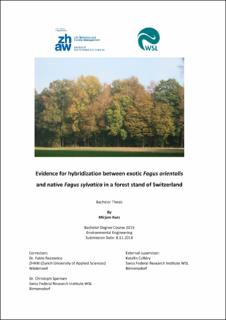Please use this identifier to cite or link to this item:
https://doi.org/10.21256/zhaw-2371| Publication type: | Bachelor thesis |
| Title: | Evidence for hybridization between exotic Fagus orientalis and native Fagus sylvatica in a forest stand of Switzerland |
| Authors: | Kurz, Mirjam |
| Advisors / Reviewers: | Rezzonico, Fabio Csilléry, Katalin Sperisen, Christoph |
| DOI: | 10.21256/zhaw-2371 |
| Extent: | 37 |
| Issue Date: | 2018 |
| Publisher / Ed. Institution: | ZHAW Zürcher Hochschule für Angewandte Wissenschaften |
| Publisher / Ed. Institution: | Winterthur |
| Language: | English |
| Subjects: | Fagus orientalis; Fagus sylvatica; Microsatellite markers (SSRs); Invasive plants; Hybridization |
| Subject (DDC): | 570: Biology 580: Plants (Botany) |
| Abstract: | Assisted migration – the intended movement of species and populations to facilitate range expansion – has recently received considerable attention in the face of climate change, since it could serve as a tool to reduce the threats posed to ecosystems and species. Particularly, it is generally expected that trees will not be able to adapt or migrate quickly enough in response to the expected climate change without human help. The topic is, however, controversially discussed, because introducing foreign species to an ecosystem can also have disadvantages, such as displacement of native species, especially when a species becomes invasive. Hybridization between introduced and native plant species is one important factor in the evaluation of invasive plants and can be a threat to biodiversity. European beech (Fagus sylvatica) is one of the economically most important broadleaved trees in Europe and is expected to experience a major shift in its natural area as a consequence of climate change. Therefore, its close relative F. orientalis (Fagus orientalis) has been proposed as an alternative for the future. But it has to be taken into consideration that these two species are known to hybridize in their contact zone in Eastern Europe. Unterstützte Migration - die Bewegung von Arten und Populationen zur Erleichterung der natürlichen Arealausdehnung - hat in letzter Zeit angesichts des Klimawandels grosse Aufmerksamkeit erregt, da es als Instrument zur Verringerung vieler Bedrohungen für Ökosysteme und Arten dienen könnte. Es wird insbesondere erwartet, dass sich Bäume nicht schnell genug anpassen oder migrieren können, um ohne menschliche Hilfe auf den erwarteten Klimawandel zu reagieren. Das Thema wird jedoch kontrovers diskutiert, da die Einführung fremder Arten in ein Ökosystem auch Nachteile mit sich bringen kann. Zum Beispiel die Verdrängung einheimischer Arten, welche insbesondere wenn eine Art invasiv wird auftritt. Die Hybridisierung zwischen fremden und einheimischen Pflanzenarten ist ein wichtiger Faktor bei der Bewertung invasiver Pflanzen und kann eine Bedrohung für die Biodiversität darstellen. Die Rotbuche (Fagus sylvatica) ist einer der wirtschaftlich bedeutendsten Laubbäume Europas und wird voraussichtlich durch den Klimawandel eine starke Veränderung ihres natürlichen Areals erfahren. Daher wurde die nahe verwandte Orientbuche (Fagus orientalis) als Alternative für die Zukunft vorgeschlagen. Dabei ist jedoch zu berücksichtigen, dass diese beiden Arten in ihrer Kontaktzone in Osteuropa bekanntlich hybridisieren. |
| URI: | https://digitalcollection.zhaw.ch/handle/11475/15381 |
| License (according to publishing contract): | Licence according to publishing contract |
| Departement: | Life Sciences and Facility Management |
| Appears in collections: | Bachelorarbeiten Umweltingenieurwesen |
Files in This Item:
| File | Description | Size | Format | |
|---|---|---|---|---|
| 2018_Kurz_Mirjam_BA_UI.pdf | 2.17 MB | Adobe PDF |  View/Open |
Show full item record
Kurz, M. (2018). Evidence for hybridization between exotic Fagus orientalis and native Fagus sylvatica in a forest stand of Switzerland [Bachelor’s thesis, ZHAW Zürcher Hochschule für Angewandte Wissenschaften]. https://doi.org/10.21256/zhaw-2371
Kurz, M. (2018) Evidence for hybridization between exotic Fagus orientalis and native Fagus sylvatica in a forest stand of Switzerland. Bachelor’s thesis. ZHAW Zürcher Hochschule für Angewandte Wissenschaften. Available at: https://doi.org/10.21256/zhaw-2371.
M. Kurz, “Evidence for hybridization between exotic Fagus orientalis and native Fagus sylvatica in a forest stand of Switzerland,” Bachelor’s thesis, ZHAW Zürcher Hochschule für Angewandte Wissenschaften, Winterthur, 2018. doi: 10.21256/zhaw-2371.
KURZ, Mirjam, 2018. Evidence for hybridization between exotic Fagus orientalis and native Fagus sylvatica in a forest stand of Switzerland. Bachelor’s thesis. Winterthur: ZHAW Zürcher Hochschule für Angewandte Wissenschaften
Kurz, Mirjam. 2018. “Evidence for Hybridization between Exotic Fagus Orientalis and Native Fagus Sylvatica in a Forest Stand of Switzerland.” Bachelor’s thesis, Winterthur: ZHAW Zürcher Hochschule für Angewandte Wissenschaften. https://doi.org/10.21256/zhaw-2371.
Kurz, Mirjam. Evidence for Hybridization between Exotic Fagus Orientalis and Native Fagus Sylvatica in a Forest Stand of Switzerland. ZHAW Zürcher Hochschule für Angewandte Wissenschaften, 2018, https://doi.org/10.21256/zhaw-2371.
Items in DSpace are protected by copyright, with all rights reserved, unless otherwise indicated.